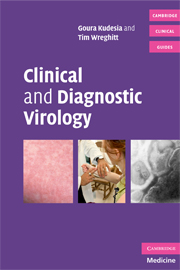Book contents
- Frontmatter
- Contents
- List of plates
- Preface
- Acknowledgements
- SECTION 1 INDIVIDUAL VIRUSES
- SECTION 2 OTHER RELATED AGENTS
- SECTION 3 CLINICAL SYNDROMES
- SECTION 4 DIAGNOSTIC TECHNIQUES
- 46 Sending specimens to the laboratory
- 47 Serological techniques
- 48 Virus detection
- 49 Molecular techniques
- SECTION 5 PATIENT MANAGEMENT
- Index
- Plate section
47 - Serological techniques
Published online by Cambridge University Press: 07 December 2009
- Frontmatter
- Contents
- List of plates
- Preface
- Acknowledgements
- SECTION 1 INDIVIDUAL VIRUSES
- SECTION 2 OTHER RELATED AGENTS
- SECTION 3 CLINICAL SYNDROMES
- SECTION 4 DIAGNOSTIC TECHNIQUES
- 46 Sending specimens to the laboratory
- 47 Serological techniques
- 48 Virus detection
- 49 Molecular techniques
- SECTION 5 PATIENT MANAGEMENT
- Index
- Plate section
Summary
Very often it is difficult to make a clinical diagnosis of a specific viral infection, as many viruses have clinically similar presentation (e.g. hepatitis viruses,Chapter 38) and the same virus can have many different clinical presentations (e.g. enteroviruses, Chapter 5). It is therefore essential to seek specific laboratory diagnosis to enable correct management of the patient. This may be important from an epidemiological perspective as well. It has been shown that even experienced clinicians are not able to clinically diagnose cases of rubella or measles correctly. A specific diagnosis of a viral rash is important, not only to the clinical management of the patient, but essential for control of infection, outbreak control and the public health perspective of continuing to ensure the efficacy of vaccination programmes.
Antibodies are produced as a host response to viral infection. Immunoglobin A is produced at the local site of infection and provides local immunity, for example in the gut or respiratory tract. The generalized humoral immune response is mounted by B lymphocytes and the first antibody to appear is of the IgM class, which can be detected as early as a couple of days after an acute infection. Some of the B lymphocyte clones then switch over to producing IgG antibody, which appears from 7–15 days after onset of infection. Both classes of antibodies continue to rise in response to the infection, peaking at about 6 weeks post infection. Viral specific IgM then declines and is normally undetectable by about 3 months after infection.
- Type
- Chapter
- Information
- Clinical and Diagnostic Virology , pp. 204 - 210Publisher: Cambridge University PressPrint publication year: 2009



